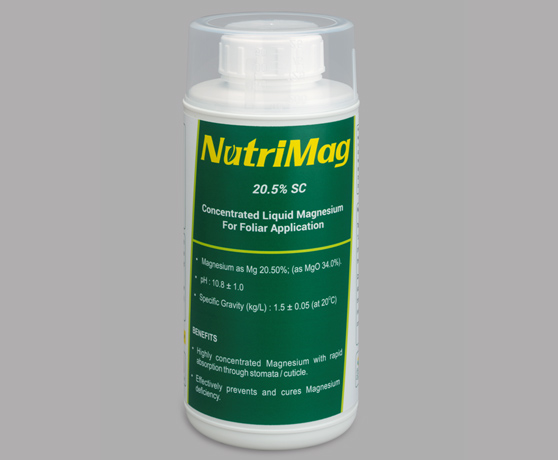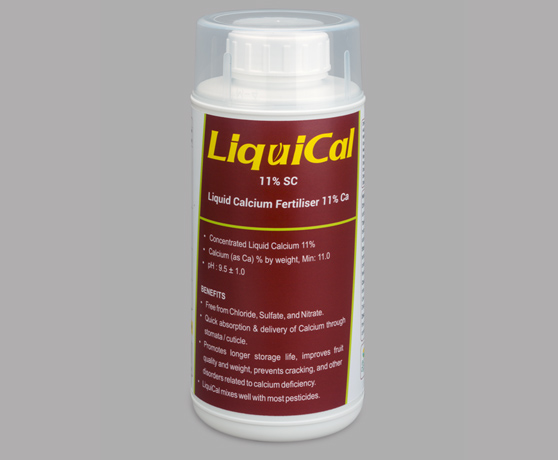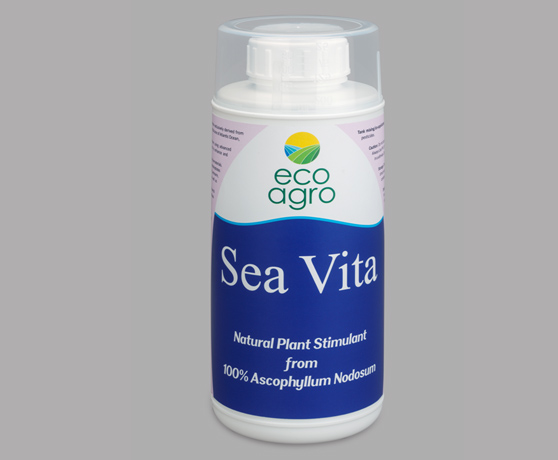


-
Calcium is only xylem mobile, meaning it can only move up the plant, and once in place, it cannot be remobilized and moved to new developing tissues. As soil reserves are depleted, Young developing tissues such as growing points and fruiting bodies are most affected. Because of calcium's low mobility in the plant, we can see calcium deficiency even in soils with high calcium levels.
MORE DETAILS
Concentrated Liquid Calcium 11%
1. Calcium (as Ca) % by weight, min.: 11.0 2. pH: 9.5 ± 1.0
1. Calcium (as Ca) % by weight, min.: 11.0 2. pH: 9.5 ± 1.0
- Free From Chloride, Sulfate, and Nitrate.
- Quick absorption & delivery of Calcium through stomata/cuticle.
- Promotes longer storage life, improves fruit quality and weight, prevents cracking, and other disorders related to calcium deficiency.
- LiquiCal mixes well with most pesticides.
- Accelerates cell division
- Accelerates germination
- Involved in root extension, and it is necessary for the secretion of protective mucilage around the root caps
- Promotes colour, flavour, and quality
- Calcium is a stationary element both in soil and plants.
- Calcium uptake from roots is very low in soil applications. Therefore, foliar fertilization is the most efficient way of providing the plant with calcium.
- Calcium does not move from old to new plant tissues and fruits. Therefore, foliar feeding is necessary during the formation and development of fruits
- Death of growing points, premature shedding of blossoms and buds, tip burn, blossom end rot and bitter pit.
- Without proper levels of calcium, the shelf life of tomatoes can be reduced significantly
- Development of necrotic tissue on young leaves
- Inhibits root growth, and in severe cases, root tips may die back
- Plants may produce soft, very small and deformed storage roots
- Calcium present in the soil is often found in the insoluble form such as calcium carbonate
- Ca-deficiency is usually related to the inability of the plant to translocate adequate Ca to the affected part.
- Soils containing high phosphorus are particularly susceptible to creating insoluble forms of calcium.
- An excessive amount of ammonium, potassium, magnesium and/or sodium in the root environment. The absorption is curbed mostly by ammonium and least by sodium.
| Sr.No | Crop | Application Stage | Advisory Dose (ml/lit of water) |
|---|---|---|---|
| 1 | Grapes (April/October Pruning) |
Stages as per EL chart: (EL 15): 8 leaves separated, (EL 23): 50% caps fall = Full bloom, (EL 27): 2 mm berry stage, (EL 29): 4 mm berry stage, (EL 31): 7 mm berry stage. |
1 |
| 2 | Pomegranate |
Fruit setting stage, 20 mm fruit size stage, 30 mm fruit size stage, 40 mm fruit size stage. |
1 |
| 3 | Banana |
60 days after transplant, 120 days after transplant, 45 days before harvest, 30 days before harvest, 15 days before harvest. |
1 |
| 4 | Citrus |
Pea size stage, Lemon stage, 50% Fruit fill stage. |
1 |
Direction for use: Continue agitation during spraying.
Tank mixing/co-application: Carry out "Jar test" before mixing LiquiCal with other products. Co-application is entirely at the risk of the end-users.
Caution: Do not exceed the appropriate application rate. Do not spray under hot and bright days. Avoid contact with skin and eyes. Always Use PPE. Do not empty into drains and waterways. Dispose of empty container in a safe way.
Storage: This product is stable under ordinary temperature. Do not expose to direct sunlight or high temperature (above 30℃). Once Opened, Use the container fully. Keep away from food, drink, animal feedstuff and children.

